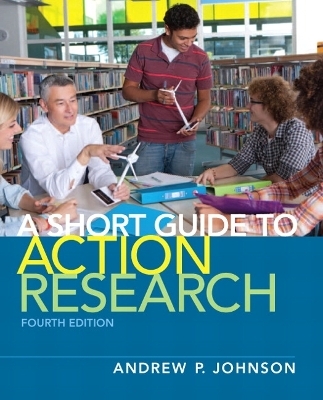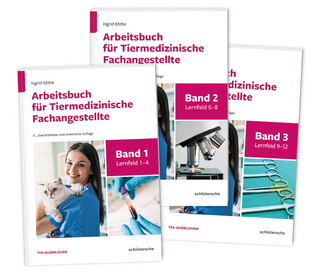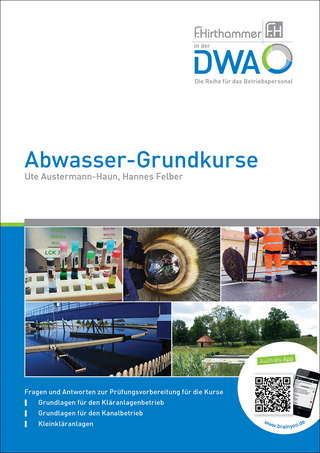
Short Guide to Action Research, A
Pearson (Verlag)
978-0-13-268586-3 (ISBN)
This book guides the learner through comprehension and interpretation of both qualitative and quantitative techniques in action research methods and then describes all phases of the process, including selecting a topic; collecting, analyzing, and reporting data; reviewing the literature; and presenting the report.
There are many new strategies and examples of projects that can be used for professional growth and development included with this edition, as well as more examples, ideas for possible research questions, and many new forms and graphics are added.
Dr. Andrew Johnson is Professor of Holistic Education and the Director of the Accelerated Teacher Licensure Program at Minnesota State University, Mankato. Here he specializes in educational psychology, holistic education, literacy instruction, and teacher professional development. Before moving into higher education he worked for 9 years in the public schools as a second grade teacher, wrestling coach, and as a gifted education coordinator. His most recent books include Making Connections in Elementary and Middle School Social Studies (SAGE) and Teaching Reading and Writing: A Guidebook for Tutoring and Remediating Students (Rowman and Littlefield). Dr. Johnson can be reached for comment at: andrew.johnson@mnsu.edu. For information related to workshops and professional development opportunities go to: www.OPDT-Johonson.com.
Chapter 1. SCIENCE, RESEARCH, AND TEACHING
I. Science, Research, and Teaching
II. Science
1. Science and Pseudoscience
II. Research
1. Quantitative Research
2. Qualitative Research
3. Quantitative or Qualitative?
III. TEACHING
1. What Scientists and Teachers Do
IV. Using Research in Education: Theories, Hypotheses, and Paradigms, Oh My!
1. Theories and Hypotheses
2. Paradigms
3. Better Decision Makers
Chapter 2. INTRODUCTION TO ACTION RESEARCH
I. Research in Action
1. A Quick Overview of Action Research
2. Descriptors of Action Research
II. The Importance of Action Research
1. The Gap between Theory and Practice
2. Teacher Empowerment
3. Teacher Inservice and Professional Growth
Chapter 3. USING ACTION RESEARCH FOR SOLVING PROBLEMS
I. FINDING THE PROBLEM
II. FINDING SOLUTIONS
1. Creative Problem Solving
2. Means—End Analysis
3. Problem-Solving Strategies in the Classroom
4. Testing the Solution
III. AN EXAMPLE OF ACTION RESEARCH AND PROBLEM SOLVING
1. Finding the Problem
2. Finding a Solution
3. Testing the Solution
IV. PROBLEM SOLVING AND INSTRUCTIONAL IMPROVEMENT
Chapter 4. THE BEGINNING
I. AN OVERVIEW OF THE ACTION RESEARCH PROCESS
1. Action Research Steps
II. FINDING YOUR RESEARCH TOPIC
1. A Teaching Strategy
2. Identify a Problem
3. Examine an Area of Interest
III. STILL HAVING TROUBLE STARTING?
Chapter 5. REVIEWING THE LITERATURE
I. REVIEWING THE LITERATURE
II. SOURCES FOR THE LITERATURE REVIEW
1. Academic Journals
2. Books
3. The Internet
4. How Many Sources?
III. STEPS FOR A LITERATURE REVIEW
IV. CITATIONS
V. THE REFERENCE PAGE
1. Journals
2. Books
VI. A SAMPLE LITERATURE REVIEW
1. Literature Review at the Beginning
2. A Literature Review at the End
Chapter 6. METHODS OF COLLECTING DATA
I. DATA COLLECTION
1. Systematic
2. Data Collection and Soil Samples
3. A Television Sports Analyst
II. TYPES OF DATA COLLECTION IN ACTION RESEARCH
1. Log or Research Journal
2. Field Notes–Your Observations
3. Checklists
4. Rating Checklist
5. Rubrics
6. Conferences and Interviews
7. Data Retrieval Charts
8. Maps
9. Artifacts: Students’ Products or Performances
10. The Arts
11. Archival Data
12. Surveys
13. Attitude and Rating Scales
14. Online Surveys and Rating Scales
15. Online Platforms and Class Journals
Chapter 7. METHODS OF ANALYZING DATA
I. ACCURACY AND CREDIBILITY: THIS IS WHAT IS
II. VALIDITY, RELIABILITY, AND TRIANGULATION
1. Validity
2. Triangulation
3. Reliability
III. INDUCTIVE ANALYSIS
1. Larry, Moe, and Curly Help with Inductive Analysis
2. Case Studies or Representative Samples
3. Vision Quest
4. Defining and Describing Categories
5. The Next Month
Chapter 8. QUANTITATIVE DESIGN IN ACTION RESEARCH
I. CORRELATIONAL RESEARCH
1. Correlation Coefficient
2. Misusing Correlational Research
3. Negative Correlation
4. Making Predictions
II. CAUSAL—COMPARATIVE RESEARCH
1. Whole Language in California
II. QUASI-EXPERIMENTAL RESEARCH
1. Quasi-Action Research
2. Pretest—Posttest Design
3. Pretest—Posttest Control Group Design
4. Time Series Design
5. Time Series Control Group Design
6. Equivalent Time-Sample Design
III. THE FUNCTION OF STATISTICS
1. Descriptive Statistics
IV. INFERENTIAL STATISTICS
Chapter 9. EVALUATING, DESCRIBING, AND PROPOSING RESEARCH
I. EVALUATING RESEARCH
1. Buyer Beware
2. Scientifically Based Research
II. EVALUATING QUANTITATIVE RESEARCH
1. Independent and Dependent Variables
2. Confounding Variables
3. Common Confounding Variables
III. EVALUATING QUALITATIVE RESEARCH
IV. DESCRIBING RESEARCH
1. Examples of Research Descriptions
V. AN ACTION RESEARCH PROPOSAL
1. Annie Oftedahl, Northfield, Minnesota
2. Ann Schmitz, Garden City Minnesota, Mankato District 77 Early Childhood Special Education
Chapter 10. REPORTING FINDINGS IN ACTION RESEARCH
I. REPORTING QUALITATIVE DATA
1. Tips for Presenting Qualitative Data
II. THE IMPORTANCE OF STRUCTURE
1. Structure and Inductive Analysis
2. Using Headings to Create Structure
3. Using Subheadings to Create More Structure
III. CASE STUDIES OR REPRESENTATIVE SAMPLES
1. It’s Alive!
IV. APPENDICES
V. REPORTING QUANTITATIVE DATA
1. Using Numbers
2. Using Words
3. Reporting Arithmetic Data
VI. TABLES
VII. FIGURES
1. Graphs
2. Other Visuals
Chapter 11. DISCUSSION: YOUR PLAN OF ACTION
I. CONCLUSIONS AND RECOMMENDATIONS
1. Christina Stolfa, Nacogdoches, Texas
2. Jo Henriksen, St. Louis Park, Minnesota
3. Cathy Stamps, Fifth Grade, Hopkins Elementary School
4. Delinda Whitley, Mt. Enterprise, Texas
5. Darlene Cempa, Whitney Point, NY
II. IMPLICATIONS OR RECOMMENDATIONS FOR FUTURE RESEARCH
1. Morgan Chylinski, Jamesville, NY
2. Karen Randle, Trumansburg, New York
III. EVALUATION OF THE STUDY
1. Jim Vavreck, St. Peter, Minnesota
2. Staci Wilson, Irving, Texas
IV. DESIGNING A NEW PLAN OR PROGRAM
1. Creating a New Plan or Program
2. A Less Formal Plan of Action
Chapter 12. WRITING AN ACTION RESEARCH REPORT
I. TONE AND STYLE
1. Avoid Value Statements
2. Extremely Objective
II. PRECISION AND CLARITY
1. Writing and Speech
2. Avoid Speech-isms
3. Avoid Non-Words
4. Use Adverbs with Caution
IV. REDUCING BIAS
1. Person-First Language
2. Exceptionalities
3. Gender
4. Sexual Orientation
5. LGBT and Transgender
6. Race and Ethnicity
V. LENGTH
VI. CLARITY
VII. HEADINGS
VIII. THE BASIC ELEMENTS OF STYLE
1. The Basics of Grammar
2. The Basics of Punctuation: Commas, Semi-Colons, and Colons.
Chapter 13. PRESENTING YOUR ACTION RESEARCH
I. THE EDUCATIONAL ENVIRONMENT
1. Your Colleagues
2. Your Students
3. School Boards, Principals, and Administrators: Making a Case
4. Your Classroom: Evaluating New Programs
5. Parent Conferences
6. As Part of a Master’s Thesis
II. THE PROFESSIONAL ENVIRONMENT
1. Professional Conferences and Conventions
2. Academic Journals
3. ERIC
III. LOCAL COMMUNITY ORGANIZATIONS
IV. MAKING EFFECTIVE PRESENTATIONS
1. Planning the Presentation
2. General Platform Skills
3. PowerPoint Specifics
4. Effective Handouts
5. Online Video Presentations
Chapter 14. ACTION RESEARCH AS MASTER’S THESIS
I. BEFORE YOU START
1. Nine Tips for Writing Your Master’s Thesis
Tina Williams
Christine Reed, Educational Specialist Degree, Nerstrand Elementary School, 6. Nerstrand, Minnesota
Jackie Royer, Master’s Thesis, Trimont Schools, Trimont, Minnesota
Darlene Cempa, Whitney Point, NY
Karen Randle, Trumansburg, New York
Morgan Chylinski, Jamesville, NY
Chapter 15. STRATEGIES FOR PROFESSIONAL GROWTH AND DEVELOPMENT
I. ACTION RESEARCH AND THE PROFESSIONAL DEVELOPMENT OF TEACHERS
1. More Knowledge Please
2. Process and Empowerment
3. Online Professional Development
4. Other Professional Development Opportunities
II. OBSERVING YOUR OWN PRACTICE
1. Best Practice
2. Audiotaping Lessons
3. Descriptive, Not Prescriptive
APPENDIX - SAMPLE ACTION RESEARCH PROJECTS
1. Alison Reynolds, Minneapolis, Minnesota
2. Kay Dicke, Eden Prairie
3. LouAnn Strachota
4. Georgina L. Pete
5. Teresa Van Batavia, Eisenhower Elementary, Hopkins, Minnesota
6. Linda Roth, St. Peter School District, St. Peter, Minnesota
7. Angela Hassett Brunelle Getty, Martinez, California
8. Michelle Bahr, Shakopee, Minnesota
9. Kim Schafer, Minnetonka, Minnesota
10. Barbara King, Prairie Elementary School, Worthington MN.
11. Annette Tousignant
| Erscheint lt. Verlag | 14.12.2011 |
|---|---|
| Sprache | englisch |
| Maße | 188 x 231 mm |
| Gewicht | 430 g |
| Themenwelt | Sozialwissenschaften ► Pädagogik ► Berufspädagogik |
| Sozialwissenschaften ► Soziologie ► Empirische Sozialforschung | |
| ISBN-10 | 0-13-268586-8 / 0132685868 |
| ISBN-13 | 978-0-13-268586-3 / 9780132685863 |
| Zustand | Neuware |
| Informationen gemäß Produktsicherheitsverordnung (GPSR) | |
| Haben Sie eine Frage zum Produkt? |
aus dem Bereich


